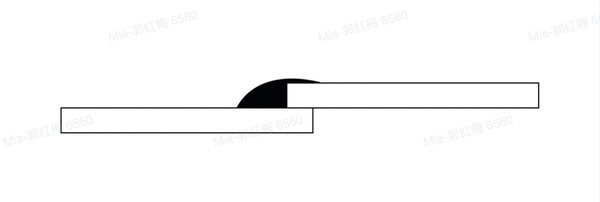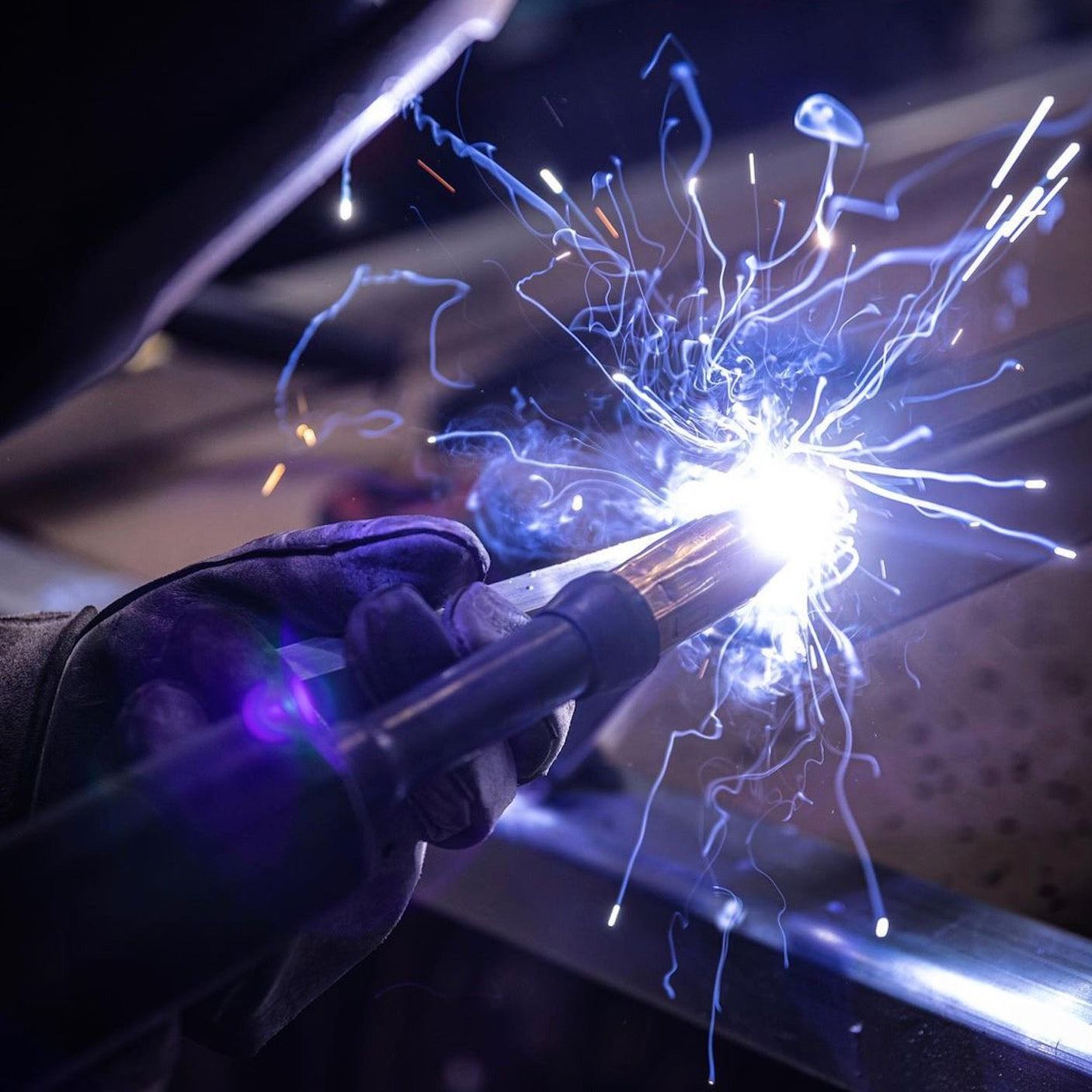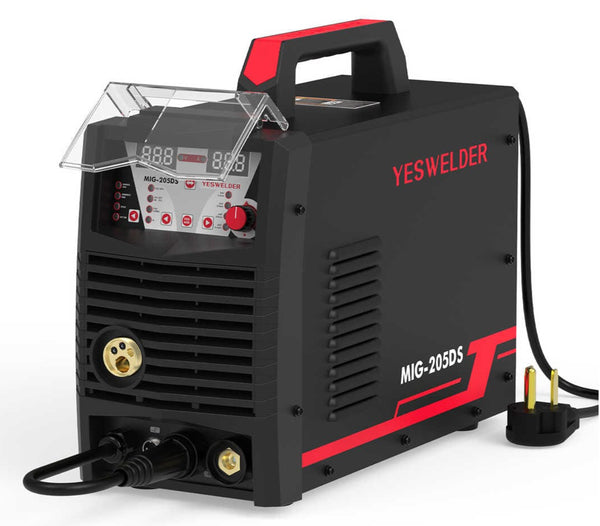How to MIG weld different metal thicknesses
MIG welding is one of the most straightforward processes, which makes it widely used by hobbyists and DIY lovers across the globe. The ease of use and versatility make this process suitable for different metals and thicknesses.
However, many beginners asked how to MIG weld different thickness metals, so we decided to help. We will explain how MIG deals with sheet metal, medium or "hobbyist" steel, and thick plates and what you will need to weld them successfully.
By the end of the article, you should understand where MIG welding shines and where it comes short.

How Does MIG Welding Deal With Different Thicknesses?
MIG welding is a pretty easy process to master and perform, and once you get the hang of it, you can weld different thickness metal without any issues. However, it will take time, practice, and an understanding of the fundamentals.
First, you should know that MIG welding deals well with thin and medium-thick metal but not so great with thick metal. Luckily, we saved you hours of grunt work and compiled a straightforward guide on how to deal with each one of these.

Photo by welding_mani
MIG Welding Sheet Metal
Gas metal arc welding (GMAW or MIG) can be successfully used to weld thin metal, but as long as you take extra care. The heat input is the main issue with sheet metal of 24 gauge up to 14 ga. Thin metal is not so forgiving, so even the slightest heat over the recommended can cause distortion, wrapping, or burn-through.

Burnthrough weld
Source: https://weldguru.com/welding-burn-through/
Therefore, welding thin metal requires adequate equipment, preparation, and technique. When chosen right, each of these will limit the heat and allow you to control the weld puddle perfectly.
So without further ado, let's see what you need and how to MIG weld thin metal.
MIG Welder For Thin metal
To prevent burn-through and wrapping of sheet metal, you will need a proper MIG welder, filler metal, and shielding gas. When choosing a MIG welder for thin metal, you can look for something other than the most powerful machine. For example, a 140 amp, 110V welder will be fine for metal up to 1/8", but you should pay attention to the lower end of welding output. With MIG welders, that's most commonly 20-30 amps, so you want to go as low as possible with thin metals.
One of the things that can significantly help in dealing with thin metal is the pulsed MIG. While this feature was reserved for high-end, expensive machines in the past, you can find it with the YesWelder YWM 211P Double Pulse MIG welder.
YesWelder YWM-211P Double Pulse Aluminum MIG Welder
This feature pulses the heat of the welding arc, allowing you to control heat while providing excellent arc stability and low spatter. Aesthetically, you can achieve TIG welding results with your MIG machine.
Welding Wire For Thin Metals
Besides the welder, you will need a suitable filler metal when welding thinner material. Remember that the filler wire diameter shouldn't be thicker than the base metal. Therefore, for metals up to 18 gauge, you will need a smaller diameter wire, such as .023.
In addition, you will need to match the composition of the MIG wire to the base metal. We recommend AWS classification ER70S6 wire that produces a good weld arc without spatter as an excellent all-around choice. Welding 304 stainless steel requires either ER308, ER308L, or ER308LSI wires, while aluminum will need a general-purpose ER4043 aluminum wire.
ER4043/1LB-0.8 1LB Spool .030" Silicon Aluminum MIG Welding Wire
Short-circuit metal transfer provides negligible heat, making it the most suitable choice when welding sheet metal. Even though spray transfer provides higher deposition rates, its heat is unsuitable for thin metal.
Shielding Gas Choice
Shielding gas plays a crucial role in welding, protecting the weld puddle from contamination. Most welders agree that the C25 mixture (75% argon/25% CO2) is the best choice for mild steel, but you should be cautious with sheet metal. CO2 in the mixture stabilizes an arc and produces a good weld bead but provides higher penetration. Therefore, to prevent burn-through, you should lower the content of CO2 in your mixture when welding metal thinner than 14 gauge.

Comparing weld bead profiles of 100% Argon to a 75% / 25% co2 MIG mix
Source: https://weldguru.com/mig-welding-with-100-argon/
MIG welding sheet aluminum will require 100% argon shielding gas. Even though pure argon in MIG welding is not the best-performing shielding gas, there is no room for exceptions. With sheet stainless steel, the common choice is a tri-gas mix of 90% helium, 8% argon, and 2% CO2.
Weld Preparation
Compared to Stick or Flux core welding, MIG is not so forgiving when dealing with dirty, greasy, or oily metal. Therefore, to successfully weld sheet metal, you must thoroughly clean welded pieces. You can use a wire brush, an old rag, and warm water or solvent to remove possible contaminants.
The next step is aligning and clamping pieces. When MIG welding sheet metal, you can opt to leave a small gap or overlap two ends of a sheet.

Overlap Welding
As a beginner, it is easier to weld if the sheets overlap. This is a more forgiving way to access it, but keep in mind that you will need a bit more heat to penetrate both pieces.
Leaving a small gap between pieces will yield stronger results, as wire fills the gap and fuses with both pieces. However, as a first-time welder, you might find it hard to control the puddle and wire distribution with such delicate work.
If you can't control the heat properly, you can add a backing bar during the weld preparation. The backing bar will act as a heatsink, allowing welds to cool faster and avoid wrapping or distortion. The backing bar should be made of copper or aluminum due to higher thermal conductivity than steel.

Source: https://amarineblog.com/2019/09/06/backing-in-welding/
Welding Parameters
After choosing the right equipment and preparing the weld pieces, you should select adequate welding parameters. The most crucial parameters include voltage, amperage, and wire speed. The challenge of choosing the correct parameters is that they depend on the thickness of weld metal, wire size, type of metal, joint configuration, welding position, or shielding gas.
So there is no universal approach to MIG welding thin metal, but there is a solution. To get the best results, follow manufacturer recommendations, which are almost always featured in the instruction manual or inside the wire compartment. In addition, you can use the synergic MIG feature, which is luckily a part of YesWelder MIG welding machines.
Synergic MIG will give you an estimated voltage, amperage, and wire feed speed based on the inputted thickness of metal, wire diameter, and shielding gas choice. However, remember that these serve as guidelines, as you might want to tweak them for the best results.
YesWelder 250A Aluminum MIG Welder Spool Gun Compatible
(MIG-250PRO-SG)
Welding Technique
The welding technique for MIG welding sheet metal is relatively straightforward. To achieve a solid weld bead, you want to keep your weld in a straight line. Weaving is not recommended, as any unnecessary heat can cause distortion.
MIG gun should be pointed at a 5-15 degree travel angle, with moderate speed. The everlasting discussion is whether to use the pull or push technique with MIG welding. Pushing is a better choice with sheet metal, as it allows a better view and control of the weld pool and lower penetration than pulling.

Source: https://www.wcwelding.com/mig-welding-tips.html
If you still struggle with wrapping and distortion, you can opt for the skip-welding technique. You should make a series of intermittent or stitch welds to minimize distortion. That way, you evenly distribute the heat, which is crucial for thin materials.

Weld Skip on a Section of Welded Tube
Source: https://blog.xiris.com/blog/detecting-skip-welds-during-fabrication
While the TIG welding processes undoubtedly produce the best results with thin metals, with the proper equipment, practice, and training, MIG can yield solid, reliable, and aesthetic welds.
MIG Welding Hobbyist Steel
Even though GMAW can deal with sheet metal, this welding process is the most suitable with the medium thickness or hobbyist steel. As hobbyist steel, we consider mild steel up to 1/2" thick. This thickness is regarded as a border between hobbyist and industrial applications, as you will rarely have a chance to work with thicker metal at your home.
Welding medium-thickness mild steel is significantly more accessible and forgiving than sheet metal, but you will still need to get things straight to finish your welding project. You will also need welding equipment, wire, preparation, and technique to do so. But this time, they are a bit different.

Photo by @welding_mani
Welder For Medium-thickness Steel
To weld medium-thickness metal up to 1/2" or 1/4", you will need a 200-250 amp rated welder with 220V input. These machines have enough power to join thicker metal with ease and our recommendation is YesWelder MIG-205DS.
YesWelder MIG-205DS-B Multi-Process MIG Aluminum Welder
This perfectly fine, compact, and easy-to-use welder, rated at 205 amps, will cover most of your hobbyist needs and deal with steel up to 1/4" in a single pass. You won't need extra features such as pulse to weld mild steel, so the MIG-205DS is a budget-friendly and suitable choice. However, to reach the maximum welding power, you will need a dedicated 220V input.
Suitable MIG Wire
As the thickness of the metal surpasses 18 gauge, you will need to switch to .030 size wire. A .030 ER70S-6 wire will cover most of your welding needs, but for steel over 3/16", you will need a .035 wire. Remember that most hobbyist MIG machines, including the YesWelder MIG-205DS, can feed the solid wire up to .035 in diameter.
ER70S-6/10LB-0.8 .030" 10LB Spool Carbon Steel Solid MIG Welding Wire
The larger wires produce higher penetration, which makes them suitable for thicker steel, but they also cause more spatter. In addition, you should match the thickness of the base metal and wire diameter to avoid a lack of fusion and undercutting, as well as excessive penetration and reinforcement.
As for the metal transfer, you will primarily use the short circuit, but you can switch to spraying to get the job done faster. This time, you don't have to worry too much about the heat-affected zone; nonetheless, you shouldn't disregard its impact on the welding area.

Source: https://www.aedmetals.com/news/mig-welding-transfer-methods
Shielding Gas
Gas metal arc welding hobbyist steel is commonly done with a C25 mixture (75% argon/25% CO2). This mixture provides a stable arc, good penetration, and a good-looking weld bead with carbon steel. Moreover, you don't have to worry about the CO2 content like with thin metal. On the contrary, you can use pure CO2 as an economical solution.
Welding with CO2 provides higher penetration, and shielding gas isn't so expensive. However, pure CO2 causes lots of spatter and bulky, rough-looking weld beads. Nonetheless, if you want to get the job done cheaper and you don’t care about aesthetics, 100% CO2 is the way.

Source: https://weldguru.com/how-to-reduce-weld-spatter/
Weld Preparation
Weld preparation for medium-thickness steel is significantly more manageable compared to thin metal but is often overlooked. You will also have to clean the weld joint, but you have more room for weld design. For example, you can use a butt weld, T-joint design, or fillet weld in a flat, horizontal, or overhead position.
Of course, the joint design will depend on specific welding projects and metal thickness, but there are certainly more options to work around than with sheet metal.

Source: http://industrial.store.shoppiko.com/blog/article/different-types-of-welding-joints
Welding Parameters and Technique
Since welding thick pieces is significantly more forgiving compared to thinner material, you have more room to experiment with welding parameters and techniques. As a rule of thumb, you will need 1 amp per .001″ of metal, but this is just a guideline, so you should always follow the manufacturer's recommendations.
A thicker piece means more heat, so do not hesitate to crack your welder. Of course, as long as you don't burn a hole in your welds. Like with sheet metal, you can use auto-set or synergic MIG controls to get things going, but you have a room full of opportunities to work your way up to the perfect results.
The same things apply to the welding technique. The travel angle of 5-15 degrees remains the same, but you should adjust the working angle to the joint configuration. In addition, you can push for better control of the weld puddle or pull when you need more penetration and a narrower bead with an immense buildup.

Source: https://weldingwatch.com/do-you-push-or-pull-when-mig-welding/
GMAW Welding Thick Plates
MIG welding thick plates is exceptionally challenging, and there are more suitable welding processes. To deal with metals thicker than 1/2", you will need a lot of effort and a powerful power source. Moreover, GMAW is not fundamentally designed for heavy-duty applications, so Stick or Flux core welding can perform better.

Source: https://apiexam.com/2015/10/11/the-variables-on-a-wps-part-1/
Nonetheless, you can do fine with the right approach and suitable equipment. Here are some tips on what to do if you encounter a thicker piece in your workshop.
Welding Equipment For Thick Metal
You will need a strong power source, a larger wire, and proper preparation to deal with thicker metal plates. While welding thin metal and medium-sized plates can be done with a single-phase 110/220V machine, you will need a three-phase power input to output enough heat.
If the thickness exceeds 3/8", you will need an industrial-grade MIG welder rated up to 500 amps. These are all massive welders, made to withstand even the harshest conditions and high heat, which is needed for a thicker piece.
Don't get me wrong, you can weld thicker plates even with your 250 amp welder, but you will have to use special preparation and multiple passes. This takes time, proper preparation, and skill, but it can be a solution when there are no other options.
MIG wire diameter for thick plates increases to .039 or up to .045 in specific applications. Compared to the thinner wire, these industrial grade fillers come in significantly larger spools, commonly 45lbs, compared to hobbyist 2 or 10 lbs. To fill larger gaps, spray transfer is used for the highest penetration and deposition, allowing you to get the job easier.

Half inch plate to channel spray transfer MIG weld.
Source: https://gowelding.org/welding/mig-gmaw/transfer-types/
Shielding gas choice depends on the application and base metal, but C25 is still the most suitable choice for steel.
Welding Preparation, Parameters, and Technique
The GMAW welding parameters and technique with thick plates still depend on material thickness, wire sizes, and results like with medium-thick materials. However, what differs is the weld preparation.
Welding extremely thick pieces will require you to grind and bevel the edges. That way, you ensure a better connection, and filling the gap will provide substantial results. In addition, certain preheating can be used. Heating the base metal to 150 and 300 degrees F will result in better penetration and more significant effects.

Source: https://www.wcwelding.com/joint-preparation.html
Final Thoughts
MIG welding can be successfully used to weld a wide variety of metal thicknesses as long as you understand the fundamentals and limitations. For example, you can use it to weld sheet metal, but you must be extra careful with the heat.
Welding hobbyist or medium-thickness metals is the most forgiving option, and there is enough room for trial and error. That's why hobbyists around the globe often use MIG to weld medium-thick metals easily.
When it comes to welding thicker plates, GMAW comes short. You will need a lot of effort and industrial-grade equipment to perform tasks successfully. So better choices are Flux core or Stick welding.













Leave a comment